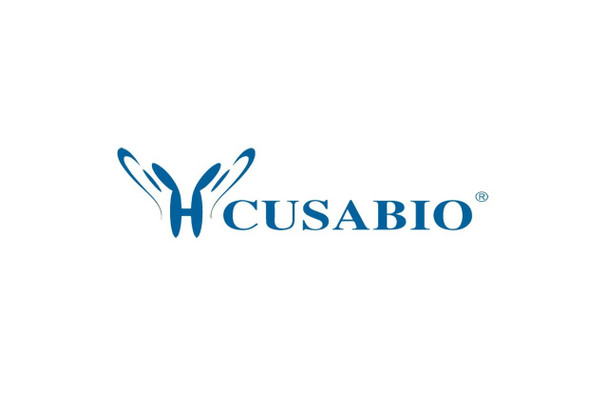Cusabio Human Recombinants
Recombinant Human Collagen alpha-2 (IV) chain (COL4A2), partial | CSB-EP005742HU
- SKU:
- CSB-EP005742HU
- Availability:
- 3 - 7 Working Days
Description
Recombinant Human Collagen alpha-2 (IV) chain (COL4A2), partial | CSB-EP005742HU | Cusabio
Alternative Name(s): Canstatin; CO4A2_HUMAN; COL4A 2; Col4a2; Collagen alpha 2(IV) chain; Collagen; type IV; alpha 2
Gene Names: COL4A2
Research Areas: Cancer
Organism: Homo sapiens (Human)
AA Sequence: VKHSQTDQEPMCPVGMNKLWSGYSLLYFEGQEKAHNQDLGLAGSCLARFSTMPFLYCNPGDVCYYASRNDKSYWLSTTAPLPMMPVAEDEIKPYISRCSVCEAPAIAIAVHSQDVSIPHCPAGWRSLWIGYSFLMHTAAGDEGGGQSLVSPGSCLEDFRATPFIECNGGRGTCHYYANKYSFWLTTIPEQSFQGSPSADTLKAGLIRTHISRCQVCMKNL
Source: E.coli
Tag Info: N-terminal 6xHis-tagged
Expression Region: 1493-1712aa
Sequence Info: Partial
MW: 28.3 kDa
Purity: Greater than 90% as determined by SDS-PAGE.
Relevance: Type IV collagen is the major structural component of glomerular basent mbranes (GBM), forming a 'chicken-wire' meshwork together with laminins, proteoglycans and entactin/nidogen.Canstatin, a cleavage product corresponding to the collagen alpha 2(IV) NC1 domain, possesses both anti-angiogenic and anti-tumor cell activity. It inhibits proliferation and migration of endothelial cells, reduces mitochondrial mbrane potential, and induces apoptosis. Specifically induces Fas-dependent apoptosis and activates procaspase-8 and -9 activity. Ligand for alphavbeta3 and alphavbeta5 integrins.
Reference: The DNA sequence and analysis of human chromosome 13.Dunham A., Matthews L.H., Burton J., Ashurst J.L., Howe K.L., Ashcroft K.J., Beare D.M., Burford D.C., Hunt S.E., Griffiths-Jones S., Jones M.C., Keenan S.J., Oliver K., Scott C.E., Ainscough R., Almeida J.P., Ambrose K.D., Andrews D.T. , Ashwell R.I.S., Babbage A.K., Bagguley C.L., Bailey J., Bannerjee R., Barlow K.F., Bates K., Beasley H., Bird C.P., Bray-Allen S., Brown A.J., Brown J.Y., Burrill W., Carder C., Carter N.P., Chapman J.C., Clamp M.E., Clark S.Y., Clarke G., Clee C.M., Clegg S.C., Cobley V., Collins J.E., Corby N., Coville G.J., Deloukas P., Dhami P., Dunham I., Dunn M., Earthrowl M.E., Ellington A.G., Faulkner L., Frankish A.G., Frankland J., French L., Garner P., Garnett J., Gilbert J.G.R., Gilson C.J., Ghori J., Grafham D.V., Gribble S.M., Griffiths C., Hall R.E., Hammond S., Harley J.L., Hart E.A., Heath P.D., Howden P.J., Huckle E.J., Hunt P.J., Hunt A.R., Johnson C., Johnson D., Kay M., Kimberley A.M., King A., Laird G.K., Langford C.J., Lawlor S., Leongamornlert D.A., Lloyd D.M., Lloyd C., Loveland J.E., Lovell J., Martin S., Mashreghi-Mohammadi M., McLaren S.J., McMurray A., Milne S., Moore M.J.F., Nickerson T., Palmer S.A., Pearce A.V., Peck A.I., Pelan S., Phillimore B., Porter K.M., Rice C.M., Searle S., Sehra H.K., Shownkeen R., Skuce C.D., Smith M., Steward C.A., Sycamore N., Tester J., Thomas D.W., Tracey A., Tromans A., Tubby B., Wall M., Wallis J.M., West A.P., Whitehead S.L., Willey D.L., Wilming L., Wray P.W., Wright M.W., Young L., Coulson A., Durbin R.M., Hubbard T., Sulston J.E., Beck S., Bentley D.R., Rogers J., Ross M.T.Nature 428:522-528(2004)
Storage: The shelf life is related to many factors, storage state, buffer ingredients, storage temperature and the stability of the protein itself. Generally, the shelf life of liquid form is 6 months at -20?/-80?. The shelf life of lyophilized form is 12 months at -20?/-80?.
Notes: Repeated freezing and thawing is not recommended. Store working aliquots at 4? for up to one week.
Function: Type IV collagen is the major structural component of glomerular basement membranes (GBM), forming a 'chicken-wire' meshwork together with laminins, proteoglycans and entactin/nidogen.; FUNCTION
Involvement in disease: Porencephaly 2 (POREN2); Intracerebral hemorrhage (ICH)
Subcellular Location: Secreted, extracellular space, extracellular matrix, basement membrane
Protein Families: Type IV collagen family
Tissue Specificity:
Paythway: PI3K-Aktsignalingpathway
Form: Liquid or Lyophilized powder
Buffer: If the delivery form is liquid, the default storage buffer is Tris/PBS-based buffer, 5%-50% glycerol. If the delivery form is lyophilized powder, the buffer before lyophilization is Tris/PBS-based buffer, 6% Trehalose, pH 8.0.
Reconstitution: We recommend that this vial be briefly centrifuged prior to opening to bring the contents to the bottom. Please reconstitute protein in deionized sterile water to a concentration of 0.1-1.0 mg/mL.We recommend to add 5-50% of glycerol (final concentration) and aliquot for long-term storage at -20?/-80?. Our default final concentration of glycerol is 50%. Customers could use it as reference.
Uniprot ID: P08572
HGNC Database Link: HGNC
UniGene Database Link: UniGene
KEGG Database Link: KEGG
STRING Database Link: STRING
OMIM Database Link: OMIM









